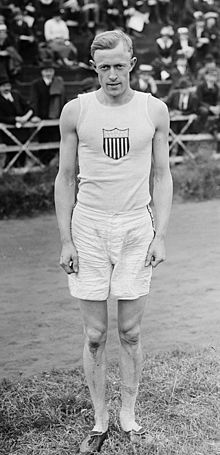Floyd Smart
 Smart in France in 1920 | |
| Personal information | |
|---|---|
| Born | April 1, 1894[1] |
| Died | November 15, 1955 (aged 61) Glen Ellyn, Illinois,United States |
| Sport | |
| Sport | Athletics |
| Event(s) | Hurdles,long jump |
| Achievements and titles | |
| Personalbest(s) | 110 mH – 15.4 (1915) 400 mH – 54.5 (1917) LJ – 6.89 (1919)[1] |
Floyd George Smart(April 1, 1894 – November 15, 1955) was an Americantrack and fieldathlete. Smart was United States champion in the440 yd hurdlesin 1917 and 1919 and in thelong jumpin 1919.
Biography
[edit]Smart became an athlete atLyons Township High SchoolinLa Grange, Illinois,[2][3]leading the school to team titles at the 1915 interscholastic meets of both Illinois (in Class B) and Michigan.[4][5][6]He was highly versatile,[7]scoring points in thesprints,hurdles,high jumpandlong jump;[8]in one 1917 dual meet betweenNorthwestern University(which he then represented) andIndianahe won six individual events.[9]
Smart won the440 yd hurdlesat the 1917Penn Relays,overtakingworld recordholderBilly Meanixon the final straight,[8][10][11]although 2 ft 6 in (76.2 cm) hurdles, rather than the usual 3 ft (91.4 cm) hurdles, were used in that race.[12]Later that year, Smart won his first title at thenational championships,defeating both Meanix and the previous year's champion,Walter Hummel;his winning time of 54.8 was only 0.2 seconds off the world record and equaled Hummel's meeting record.[13][14]In 1918 Smart underwentmilitary officer trainingatCamp Grantand qualified as a lieutenant; like many other top athletes, he missed that year's national championships due toWorld War I.[15][16]
Smart returned to competition in 1919, and was favored to regain the national 440 yd hurdles title.[17]He won the event in 55.6, ahead of Meanix;[18]he won a second title in thelong jumpwith a jump of 22 ft7+1⁄4in (6.88 m), overtaking his Chicago A.A. clubmateSherman Landersin the final round.[18][19][20]
In June 1920 Smart won the 440 yd hurdles in 55.6 at the Midwestern Tryouts, a qualifying meet for theUnited States Olympic Trialsof that year.[21]At the final Trials, however, he only made it past the heats as a fastest loser, and was eliminated in the semi-finals.[22]He was named to theOlympic team,[23]but only as an alternate, and did not get to run at the Olympics; instead, he represented the United States in meets against the national teams of Sweden and France (in Paris) and theBritish Empire(in London). He won the 400 m/440 yd hurdles in both of these meets.[24][25][26]
Smart died at his home inGlen Ellyn, Illinoisin November 1955. He was survived by wife, two sons and a daughter.[2]
References
[edit]- ^abFloyd G. Smart.trackfield.brinkster.net
- ^ab"Hold Services Saturday For Ex-Track Star".Chicago Tribune.November 17, 1955.RetrievedNovember 18,2014.
- ^"Maroon 'Preps' Win Suburban Track Honors".Chicago Daily Tribune.March 20, 1915.RetrievedNovember 19,2014.
- ^"Gordon's Team Won".Fort Scott Tribune.June 15, 1915.RetrievedNovember 19,2014.
- ^The Michigan Alumnus.University of Michigan Alumni Association. 1915. p. 482.RetrievedNovember 30,2014.
- ^Eckersall, Walter H. (May 16, 1915)."Chicago Schools Win Most of Prep Prizes".Chicago Daily Tribune.RetrievedNovember 19,2014.
- ^"Arthur Duffey's Comment".Boston Post.July 1, 1917. p. 14.RetrievedNovember 19,2014.
- ^ab"Smart Hailed Coming Champ".Racine Journal-News.June 4, 1917.RetrievedNovember 19,2014.
- ^United Press(May 13, 1917)."Northwestern Wins By One Point".Daily Missourian.RetrievedNovember 19,2014.
- ^"Berry Victor in Pentathlon".The Boston Globe.April 28, 1917.RetrievedNovember 24,2014.
- ^"Five Enter Philadelphia Meet".The Harvard Crimson.April 25, 1917.RetrievedNovember 18,2014.
- ^"Blanchard Ties For First Place In Weight Throw".The Harvard Crimson.April 28, 1917.RetrievedNovember 23,2014.
- ^"B.A.A. Third in Senior Events".The Boston Globe.September 2, 1917. p. 13.RetrievedNovember 18,2014.
- ^Mallon, Bill; Buchanan, Ian;Track & Field News."A History Of The Results Of The National Track & Field Championships Of The USA From 1876 Through 2011".Track & Field News.Archived fromthe originalon November 29, 2014.RetrievedNovember 18,2014.
- ^"Burwell to Compete in Title Meet"(PDF).Syracuse Herald.March 24, 1918.RetrievedNovember 19,2014.
- ^"Champions in the Service".The Pittsburg Press.May 24, 1918.RetrievedNovember 30,2014.
- ^Baker, Homer (September 7, 1919)."Probable Winners Picked By Baker"(PDF).The New York Times.RetrievedNovember 23,2014.
- ^ab"Joie Ray Sets New A.A.U. Championship Record For One Mile Run"(PDF).The New York Times.September 14, 1919.RetrievedNovember 23,2014.
- ^"Ray Smashes A.A.U. Record In The Mile".The Boston Globe.September 14, 1919.RetrievedNovember 23,2014.
- ^Mallon, Bill; Buchanan, Ian;Track & Field News."A History Of The Results Of The National Track & Field Championships Of The USA From 1876 Through 2011".Track & Field News.Archived fromthe originalon December 5, 2014.RetrievedNovember 19,2014.
- ^"Ray Runs Mile In 4:16 At Chicago".The Sun and New York Herald.June 27, 1920.RetrievedNovember 30,2014.
- ^Hymans, Richard."The History of the United States Olympic Trials – Track & Field".USA Track & Field;Track & Field News. Archived fromthe original(PDF)on March 3, 2016.RetrievedNovember 18,2014.
- ^"Olympic Games Handbook".American Sports Publishing Co. 1921. p. 23.RetrievedNovember 30,2014.
- ^"Kirksey Ties Mark In 200-Meter Dash"(PDF).The New York Times.August 30, 1920.RetrievedNovember 23,2014.
- ^"U. S. Athletes Tie in Meet With Britons".New York Tribune.September 5, 1920.RetrievedNovember 23,2014.
- ^"American and British Athletes Tie at 5 to 5".The Sun and New York Herald.September 5, 1920.RetrievedNovember 23,2014.
